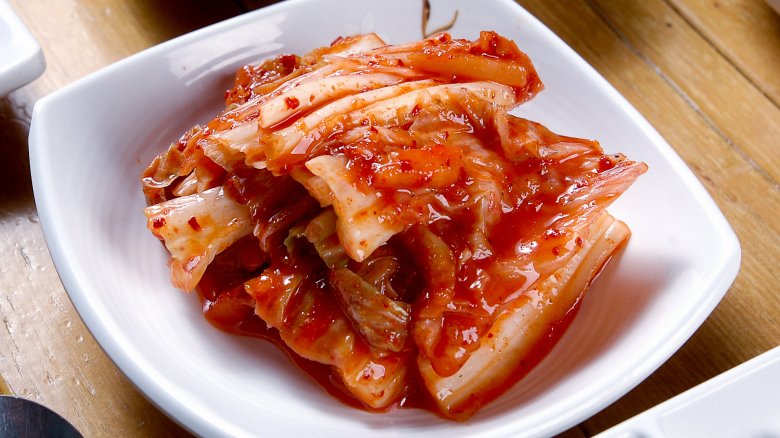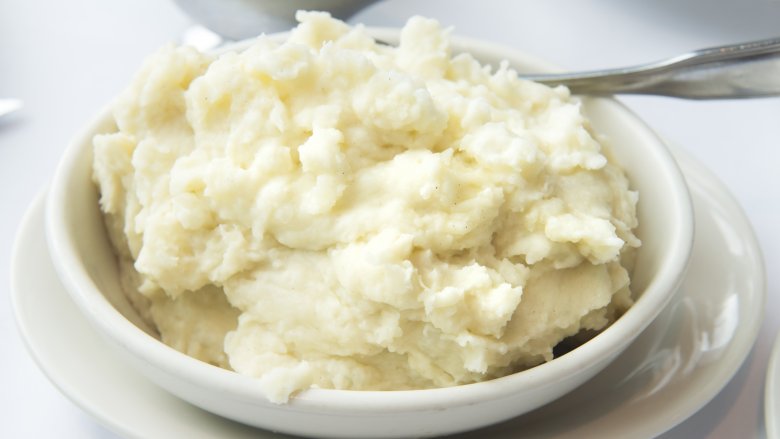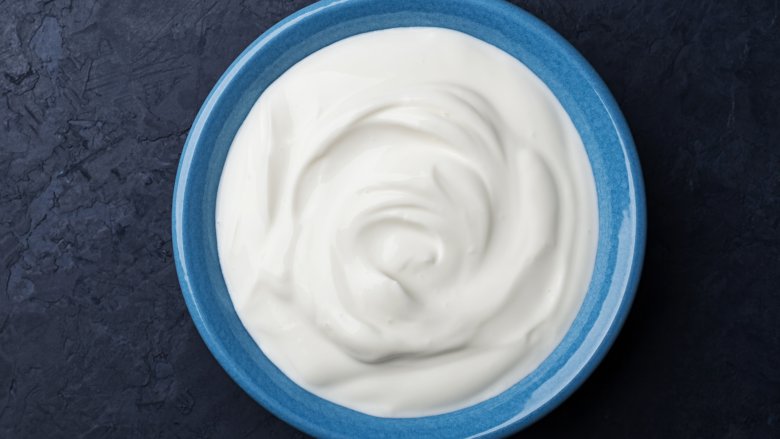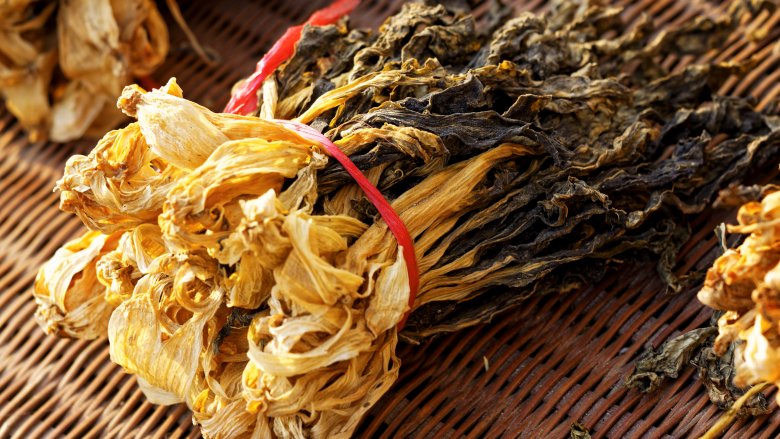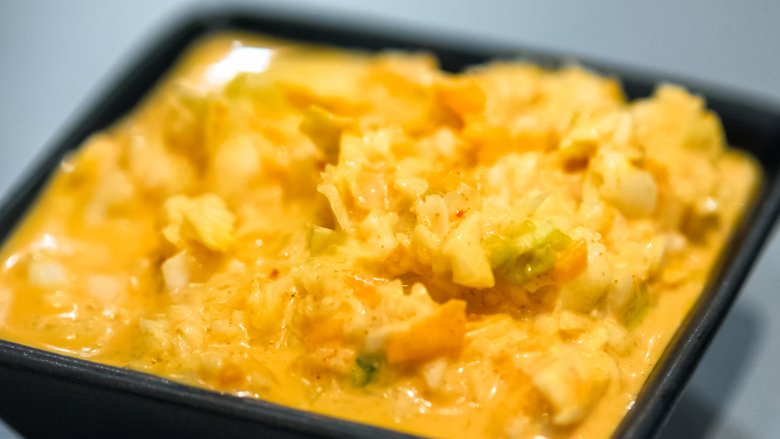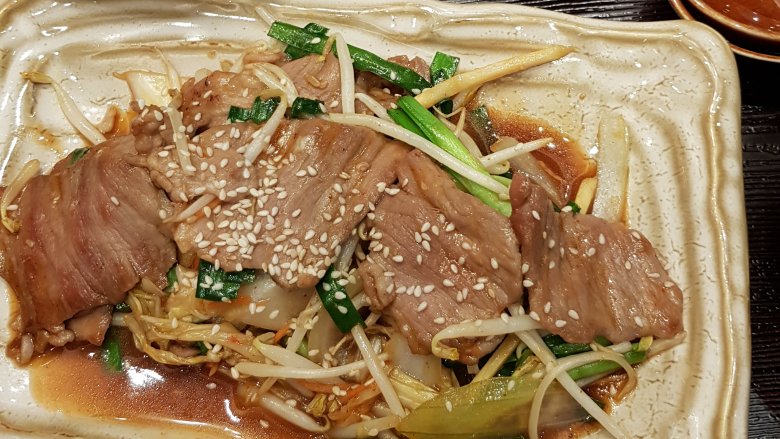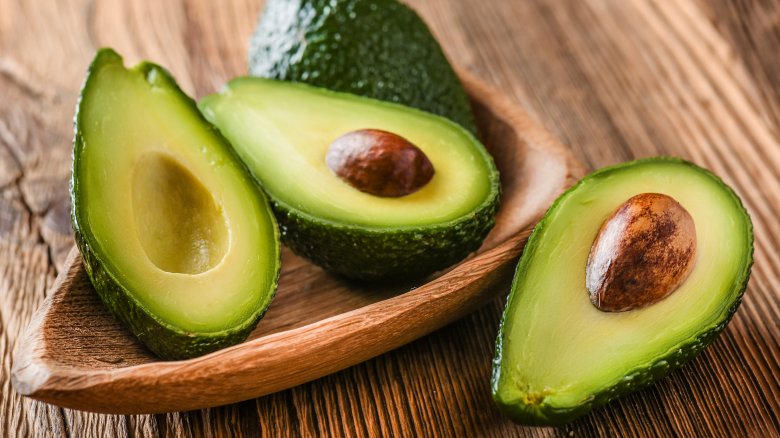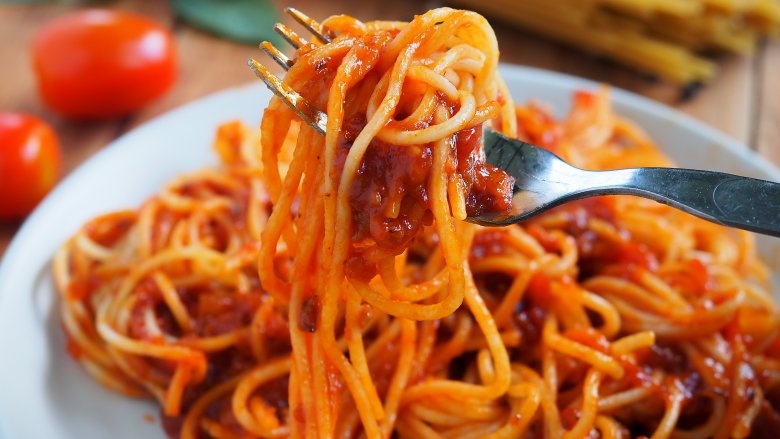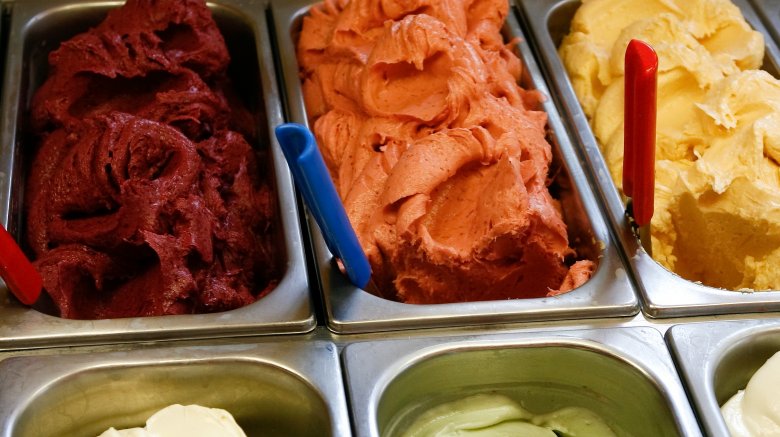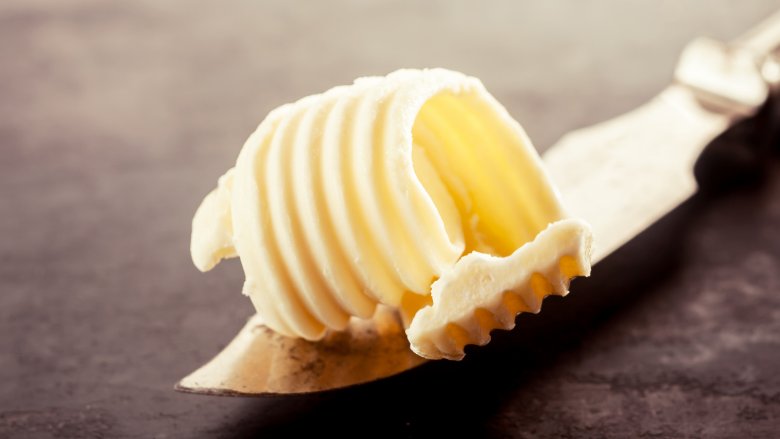12 Ways To Use Kimchi You Haven't Thought Of Yet
intro
We may receive a commission on purchases made from links.
Kimchi is the national dish of Korea, and it is rare to sit down to a Korean meal without finding kimchi on the side. The dish dates back to ancient times when Koreans preserved vegetables for the long winter by salting them. This became more developed in the medieval Koryeo period as new vegetables entered the country and as garlic and spices were added. The kimchi we know today had its origins in the 1592 introduction of red chili peppers from the New World by way of Japan. Today there are hundreds of different varieties of kimchi, but the most popular is baechu kimchi made from napa or Chinese cabbage. This tangy and spicy kimchi has been ascendant in the culinary world, as Korean and overseas Korean chefs show the world what it can do — and nutritionists show us how beneficial it can be. For this article, I'll mostly focus on baechu kimchi. There are still more mountains to conquer when it comes to the possibilities of kimchi, but this is a good start.
In mashed potatoes
This variation of a Thanksgiving classic comes to us by way of Debbie Lee, the owner of Los Angeles Korean-American restaurant Ahn Joo, whose parents immigrated to the United States in the early 1960s. As her mother had been too young to learn Korean cooking, Lee grew up in Jackson, Mississippi, with a largely Southern diet.
Thanksgiving dinner had the staples you'd expect: giblet gravy, sweet potato pie, and buttermilk mashed potatoes. But a wild card was thrown in the mix by Lee's grandmother, who would invariably bring a jar of kimchi with her. Lee added the kimchi to her plate out of politeness and the juice would leak into her mashed potatoes. She started mixing the two together and had a eureka moment.
Growing up to be a chef, restaurant owner, and author, she refined the recipe to a high standard. Sweet potatoes, russet potatoes, carrots, onion, and garlic are cooked in a buttermilk and chicken broth, then smashed and combined with salt, pepper, and kimchi. What began as "an accident of the melding of flavors on your plate" is now something you can enjoy at home. And who doesn't loved mashed potatoes?
With yogurt
I know from personal experience that leaving yogurt and kimchi together in the fridge together can lead to unintended flavor combinations, and it may unpleasantly surprise a partner or guest when they eat try to have berries and yogurt for breakfast. Whoops.
But when it's done deliberately, the combination makes a lot more sense. Kimchi, yogurt, and other fermented foods are both recommended for facilitating digestion and some science has linked them to a positive impact on the brain, reducing anxiety and neuroticism. They are also both probiotic, helping your digestion. And if you just care about taste, their flavor profiles complement each other quite well.
Food manufacturer Meiji released a recipe for its Bulgaria Yogurt website combining strained yogurt and kimchi in a rice bowl for a healthy and delicious snack. When Rocket News tested the recipe with soy sauce and fish flakes for seasoning, it was found to be visually off-putting but incredibly delicious.
But the combination that gets me most excited, if guiltily, is Dale Talde's incredible recipe for Korean fried chicken with a kimchi yogurt marinade. This is a bit of a cheat example, as the recipe is based on the flavor profile of kimchi rather than using kimchi itself as an ingredient, but it's simply too amazing to ignore. Leave this one for special occasions.
As dried chips
When Trader Joe's introduced dehydrated kimchi chips, the reactions were all over the place. Some were unimpressed by the end result, with one reviewer calling it a "food absurdity," while others loved them as both a snack and an ingredient in soup or ramen. Back in 2012, Oghee Choe and Connie Choe-Harikul from Granny Choe's Kimchi Company won the Good Food Day LA cabbage cooking contest with their version of a dehydrated kimchi chip.
After seeing a photo of the Trader Joe's kimchi chips, blogger MAS decided to try his hand at making his own. He took a batch of homemade kimchi and popped it in the dehydrator for 10 hours to produce deliciously crunchy kimchi chips. The dehydration time and the fact it took six days for fermentation in the first place convinced MAS it was more trouble than it was worth.
Still, if you have access to a dehydrator and a source of good kimchi, this could be a delicious snack. It's also healthy, although most of the probiotic benefits would be lost in the process. My gut says the more pungent the kimchi, the better the highly concentrated results would be, but I make no assurances.
With cheese
Not enough people know about kimchi and cheese. Most still think the combination is unappetizing at best and chaos at worst. I have to set the record straight. Kimchi and cheese together is surely the food of the gods.
Roy Choi has done good work by popularizing the kimchi quesadilla with his Kogi food truck, famous for its cunning combination of Korean and Tex-Mex food. His recipe for the dish appeared in Gourmet magazine in 2009, which should be enough to silence haters who accuse you of culinary heresy. Not to be outdone, Taco Bell Korea later followed the trend by introducing the kimchi quesadilla to its menu to local acclaim. Sadly, the company is reluctant to export the menu item to the American market. Then again, kimchi and cheese in a quesadilla isn't exactly rocket science, so no one needs to miss out.
But it's not just Tex-Mex that benefits from the combination. Good quality kimchi and cheese make a simply wonderful grilled cheese sandwich, perhaps the best way to win converts to the marriage of the two ingredients. Meanwhile, Maggie Zhu from the Omnivore's Cookbook took things a step further, developing a variation of traditional Korean kimchi pancakes utilizing mozzarella cheese and whatever leftover meat you have in the fridge to make an amazing breakfast. Thank you, Maggie, you're doing God's work.
On pork chops
In general, Koreans don't tend to eat meat on the bone. But they do love pork, and pork and kimchi is hardly a rare combination, most notably in jeyuk-bokkeum spicy stir-fried pork. It only makes sense that kimchi on pork chops works as well. Marinating pork chops in kimchi for 30 minutes to 24 hours infuses the meat with spiciness and tang, and combining the kimchi with vermouth and honey makes for a simple but powerful pan sauce for seared pork chops.
A backend alternative comes from hannaone on Chowhound and takes things a step further. Take a thick-cut pork chop and cut an X into the center, then stuff it with kimchi, garlic, and other seasonings that will infuse into the meat while cooking.
With avocado
When you think about it, kimchi and avocado have more in common than it would seem. Both have their passionate defenders and their fierce critics. It only makes sense to combine the two and see how they fare together, right?
The Fermenter's Club has a recipe for kimchi guacamole, which they have tried to dub gua-kim-ole. Despite the lame name, I think the idea is sheer genius. They warn the recipe won't last for longer than a couple days, but that shouldn't be a problem.
The Chubby Vegetarian has a recipe for an avocado and kimchi sandwich with tempeh and cilantro vaguely reminiscent of the Vietnamese banh mi. A great choice for vegans, vegetarians, and meat eaters alike, though traditional and store-bought kimchi usually contain non-vegetarian ingredients.
In fact, a lot of people have fallen in love with the fusion of creamy avocado and tart kimchi flavors, whether in the form of quesadillas, toast or even ramen noodles.
In spaghetti
A version of kimchi spaghetti became famous (in certain benighted circles) when Kyungsoo from the Korean pop idol group EXO gave his own recipe during a radio interview. This was reposted thousands of times and fans developed their own variations on what is basically a stock standard bachelor chow spaghetti with cooked kimchi mixed in.
Despite this dubious provenance, the flavor profile of adding kimchi to tomato-based pasta sauces actually makes sense. According to Marc Matsumoto from NoRecipes.com, leftover kimchi found in the bottom of the refrigerator has usually achieved the best level of pungency to give a pasta dish an umami kick. Korean Babsang recommends adding pork belly, Italian sausage, or pancetta, as well as anchovies to drive home the Korean-Italian fusion.
In a cocktail
Although some Korean food purists find this concept horrifying, the tartness of kimchi juice or puree can actually work pretty well in a cocktail. There are several variations on the concept of a kimchi bloody mary. Natalie Migliarini from Beautiful Booze found blending kimchi into the cocktail produced "ridiculous flavor," well-balanced by V8 juice and ginger. Topped with kimchi and toasted seaweed, it makes for a handsome beverage. Food and Wine magazine also released a kimchi bloody mary recipe, but it uses Sriracha which is either misguided or cheating.
Rocket News also tested a variation of the concept, substituting the Korean national drink soju for the vodka more traditionally found in a bloody mary. The recipe first appeared on a Korea Tourism Organization's website which has since mysteriously disappeared and been replaced by a Spanish-language blog. According to internet archives, many commenters objected to the fact a beverage averages Koreans don't drink was promoted on a government website. We get their point, but would still like to tell whoever came up with the idea they shouldn't listen to the haters.
Then again, the sort of person who has a kimchi cocktail to cure their hangover probably doesn't care much about the opinions of others.
In ice cream
This one is a stretch even for the most dedicated kimchi enthusiasts. Actually it sounds like absolute madness. But it's said to work. The flavor was developed for the Korean barbecue restaurant Seoul Q by Clementine's Creamery, an outfit notorious for their innovative flavors. Seoul Q's David Choi admitted, "When we first came up with it, we wanted a flavor that we knew no one else has. Surprisingly enough, it came out very tasty."
The secret comes down to the fact if you leave kimchi on a hot grill, it will start to caramelize and develop sweet notes. Through rigorous experimentation, Choi figured out how to harness the kimchi fermentation process to create unique and palatable ice cream. Combined with honey and mint, Choi's kimchi ice cream brings together sweetness, a bit of heat, and a funky sourness. This is complex ice cream for adults, not just madmen.
The Salt and Straw ice cream shop in Los Angeles and Portland also has a kimchi and rice ice cream developed by chef Bo Kwon, which is described somewhat floridly: "sweet, clear, kimchi taffy, bright red and floral, with lots of fermenty tang and spice, is rippled throughout, and chunks of bulgogi-kimchi truffles stud this ice cream's firmament with fused chocolaty promise." Whoa nelly. A more approachable but savory version has been developed by blogger Meatloaf Princess for the brave and bold to make at home.
As a soda
While I've held an unabashed pro-kimchi stance, even I have my limits. Braver souls at Rocket News tasted a range of flavors from the Japanese Ramune soda brand, including corn soup, curry, spicy sesame oil, salted watermelon, takoyaki octopus balls, and kimchi. The smell of the kimchi soda was so strong the reviewer initially reeled but ended up choosing it as his favorite of the bunch thanks to the way it captured the savoriness and zest of real kimchi. You don't need to go all the way to Japan to try it, though; the soda is available through Amazon.
Not to be outdone, the Korean drink company Coolpis also sells a kimchi juice drink which is somewhat less popular than its peach-flavored drink. This seems less insane than a carbonated beverage, but some may ask why anyone would want a refreshing drink tasting of spicy fermented cabbage. Then again, it might be pretty good in a bloody mary.
With wine
While working as the tasting editor for Wine & Spirits Magazine, Lauryn Chun was struck by how the aroma of a vintage Bordeaux called forth childhood memories of the smell of fermenting cabbage and soy bean paste. When she began to write her Kimchi Cookbook, she began to explore the parallels and complementary natures of wine and kimchi as fellow members of the fermentation fraternity.
Kimchi is as diverse as wine in many ways and serves much the same function of complementing a meal. Over time, Chun developed her own scheme of kimchi and wine pairings. For napa cabbage wine, she recommends a Beaujolais nouveau, as the lack of tannins help bring out the fruitiness in the kimchi seasoning. For daikon kimchi, she recommends a gruner veltliner or a German kabinett riesling to complement the kimchi's tart heat.
When Wine & Spirits Magazine assisted Chun in her investigations, they found that with the exception of the Beaujolais nouveau, most of the wines successfully tested for kimchi pairings were light white wines with a sweetness to balance the heat.
The combination isn't really as odd as it seems, when you think about it. As Chun says, "Kimchi is naturally fermented — like wine, and the acidity is less aggressive than in a pickle. Also like wine, it's alive, changing as it ages, mellowing in its bite. A good kimchi might even bubble, a little like Champagne."
And before anyone asks, I'm saying kimchi can pair well with wine. Don't put kimchi in your wine.
In butter
Say what you want about Momofuku Milk Bar's David Chang. He may have angered millions of Australians for his rash and unkind words about beetroot on the Aussie burger. But he remains a man of talents, and one of his great achievements has been combining kimchi with butter.
Chang's kimchi butter is relatively easily made by mashing salted butter with finely chopped kimchi and kimchi juice and leaving the mix in the fridge for somewhere between an hour and a week. It is a glorious thing, so much so the Momofuku Milk Bar has had to start selling its own jars. It has been used with success on steak, burgers, vegetables, and scrambled eggs.
Kimchi butter is also a key ingredient in Momofuku's famous kimchi and blue cheese croissants. While it may sound like a mess, the kimchi butter infuses with the dough to give a subtle sour and smoky flavor to the specialty.
